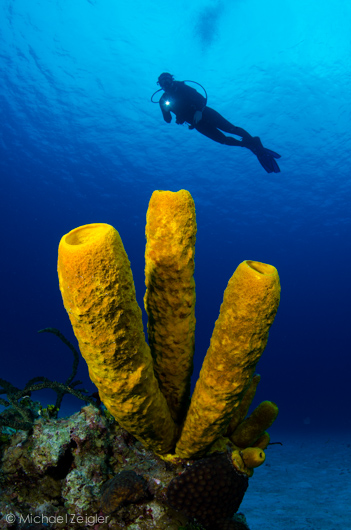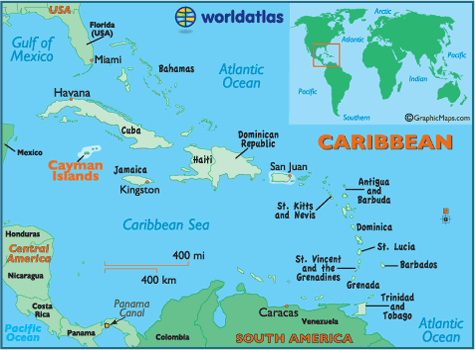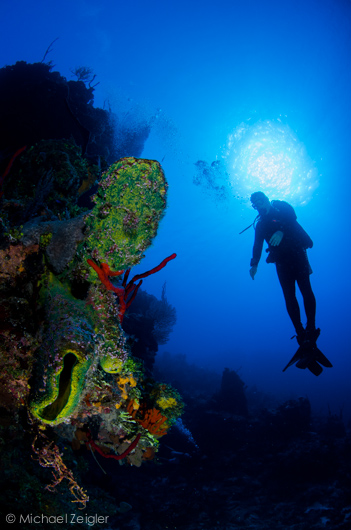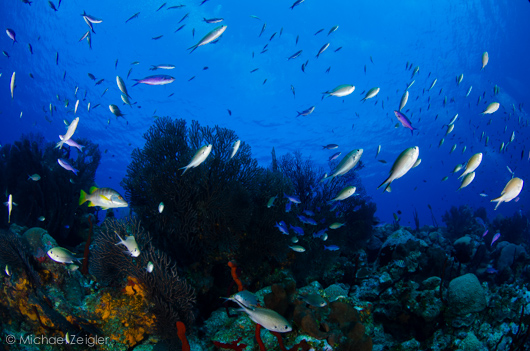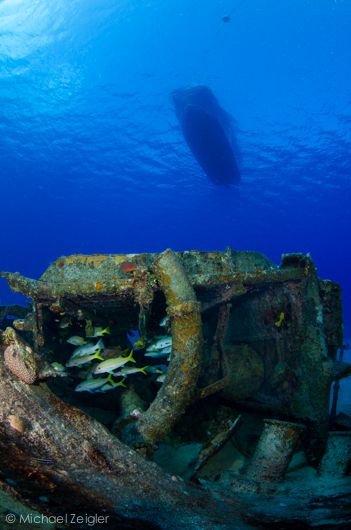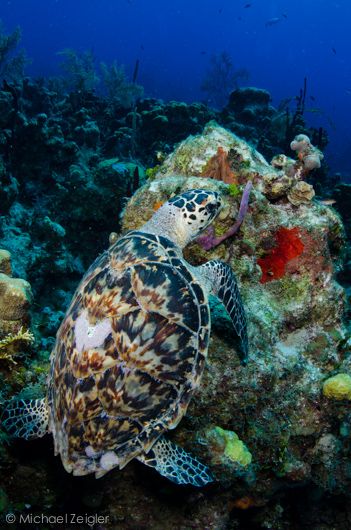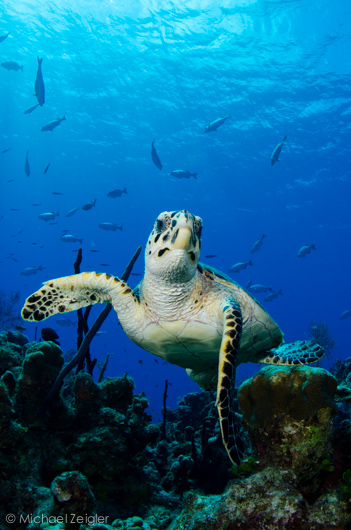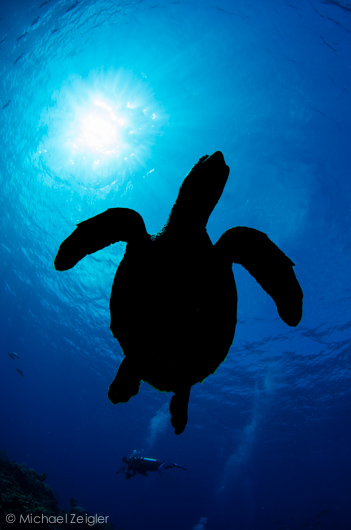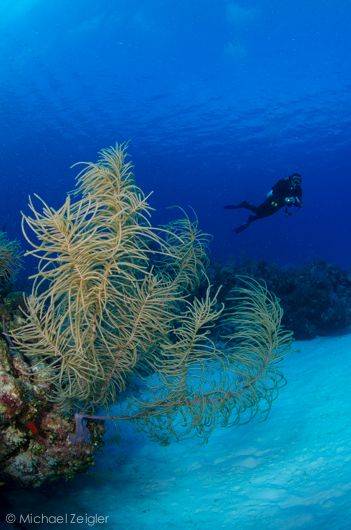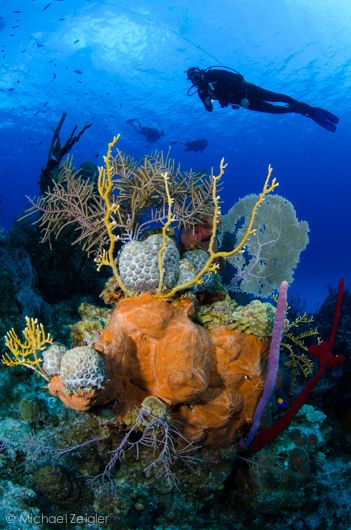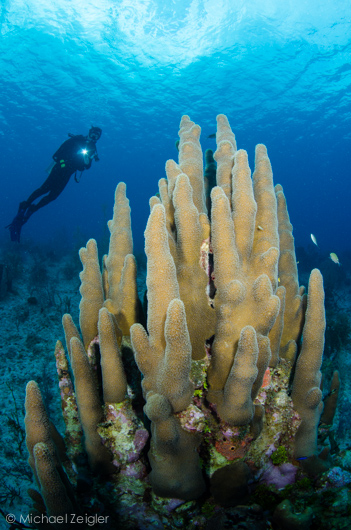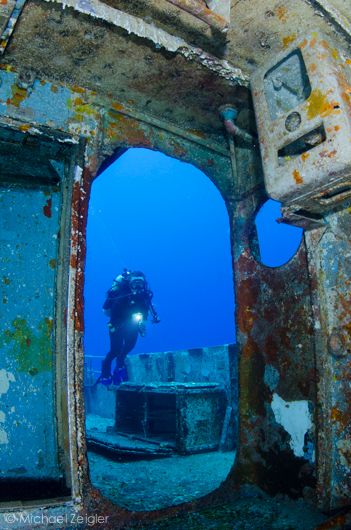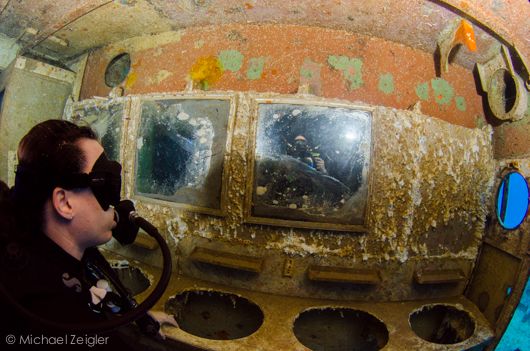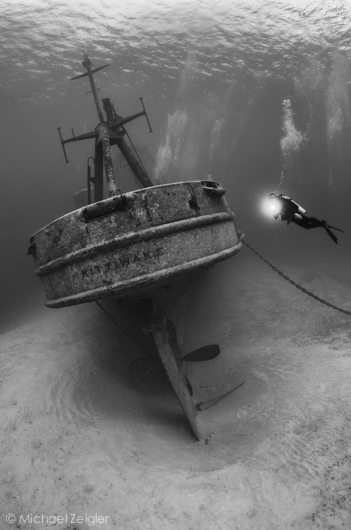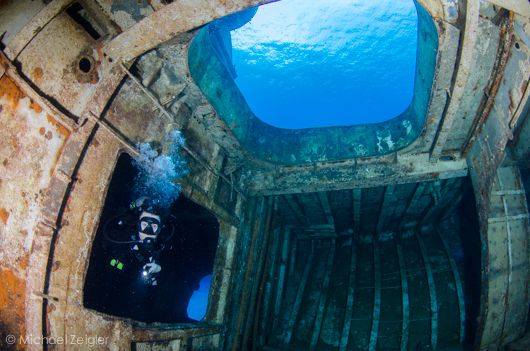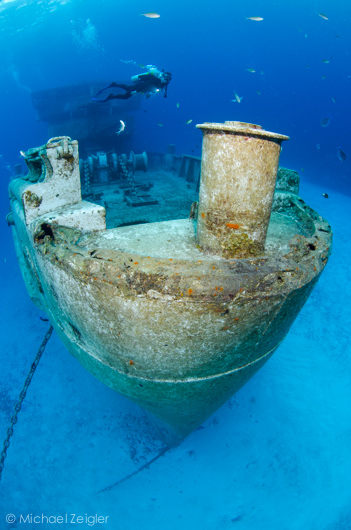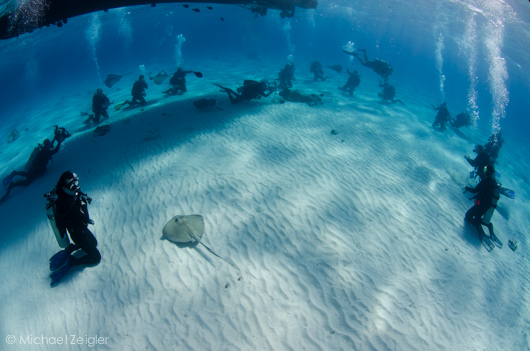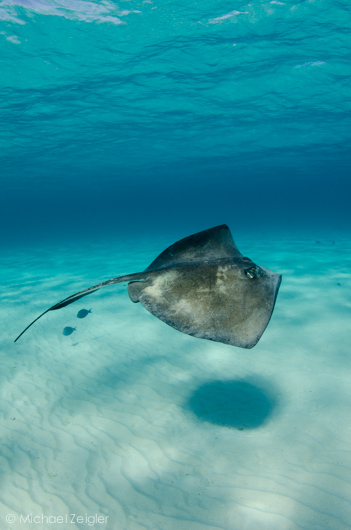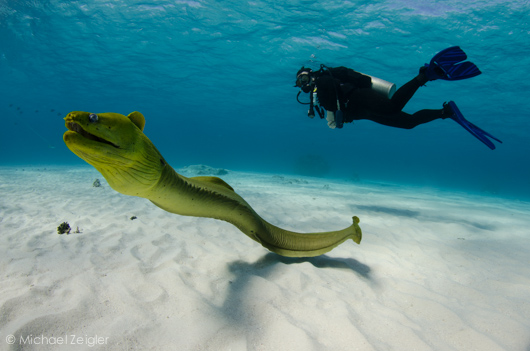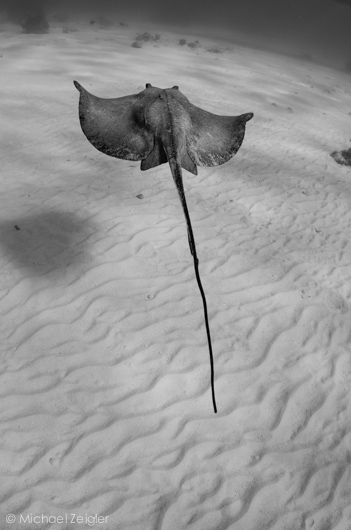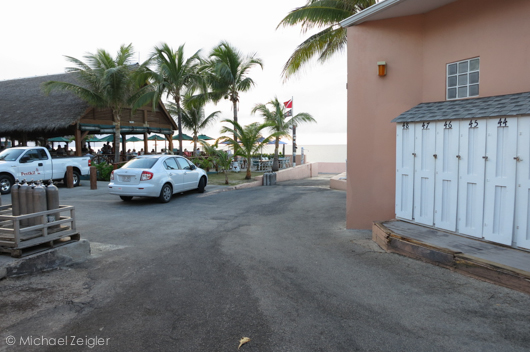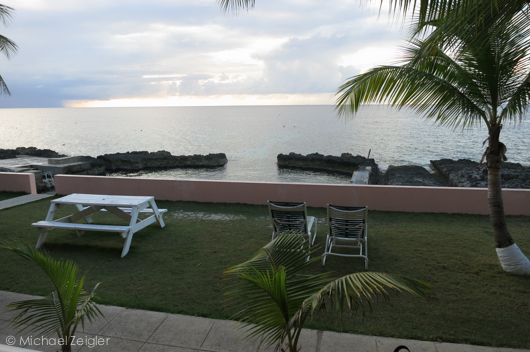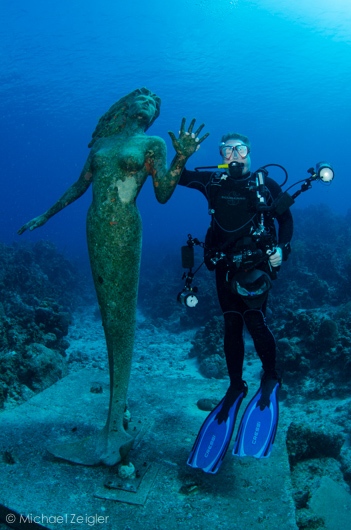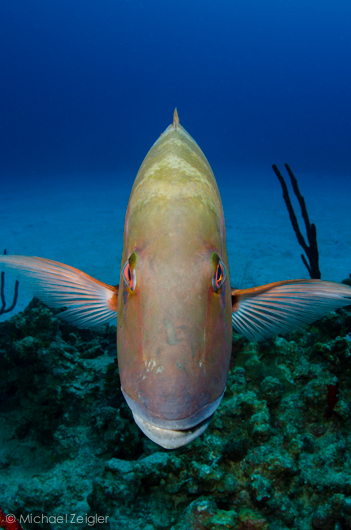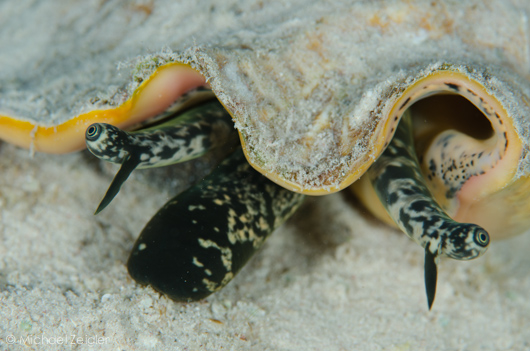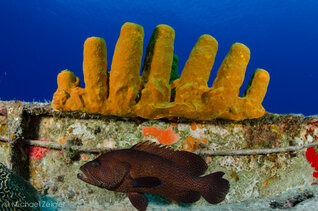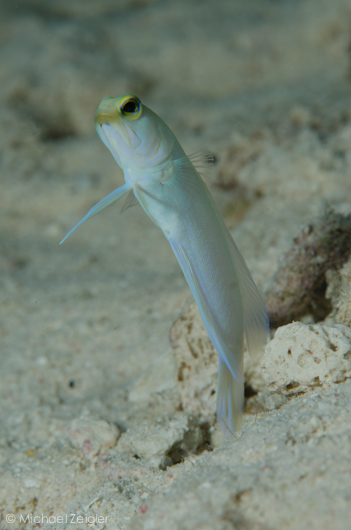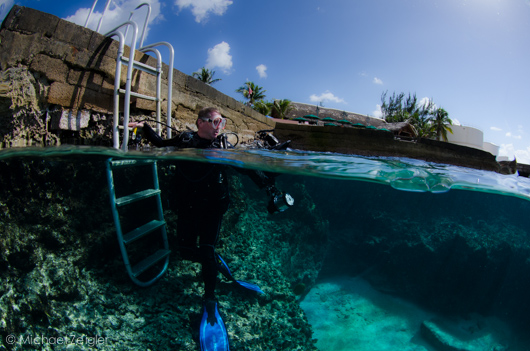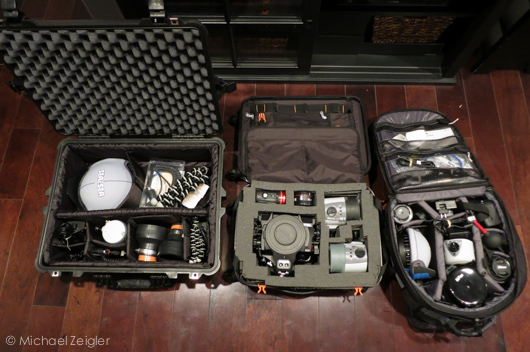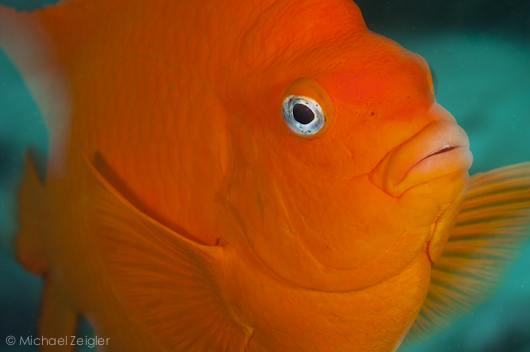
Dive Adventure: Grand Cayman
Amazing underwater photography opportunities abound in Grand Cayman
By Michael Zeigler
When I heard that my employer’s annual “Apex Award” trip in January was to Grand Cayman (sweet!), I immediately started mentally preparing for all of the great underwater photo opportunities that were sure to present themselves. While I primarily enjoy diving in the rich waters of southern California, I was eager to don a much thinner wetsuit and plunge into some warm blue water. Lots of research ensued, and it all paid off.
A friend of mine that I met at our 2011 underwater photography workshop in La Paz highly recommended Sunset House, and it turned out to be a fantastic choice. Although most of the trip contained pre-planned activities with my company at another hotel, my wife and I stayed a few extra days at Sunset House to get in some much needed warm water diving. I was able to squeeze in eight dives during the trip, and I loved every minute.
Equipment
All photos were taken with a Nikon D7000 in a Sea & Sea housing, Tokina 10-17mm fisheye lens behind a 10″ Sea & Sea dome port, and dual Ikelite strobes unless otherwise noted.
Colorful bouquets of sponges can be found at most of the dive sites along Grand Cayman’s famous Seven Mile Beach.
Location
Located ~275 miles south of Cuba in the Caribbean Sea and a short 90 minute flight from Miami, Grand Cayman is the largest of the three Cayman Islands. The other two Cayman Islands, Little Cayman and Cayman Brac, are ~85 miles northeast of Grand Cayman.
Map courtesy of worldatlas.
Dive Sites along Seven Mile Beach
Big Tunnels
Massive sponge-covered walls, deep crevices, and swim-throughs greeted us in just the first few minutes of my first dive of the trip. I was sure to keep my eyes peeled into the blue for the occasional “big” critter. They recently had sightings of eagle rays, and the very rare manta ray. My dive guide, Pete, took me on a fantastic tour of the reef, and pointed out some amazing black coral which was surrounded by schools of fish.
My dive buddy enjoys the view along the colorful wall at Big Tunnels.
Massive fans of healthy black coral are surrounded by schools of blue chromis, brown chromis, and the occasional schoolmaster.
Paradise Reef
This shallow reef (60 fsw) is also the home of the Oro Verde wreck. As I descended toward the wreck, I kept my eyes on the sand flats, hoping to spot an eagle ray hunting for garden eels. The wreck is scattered over a relatively large area, which allows for plenty of exploration.
Next to the wreck, the reef teemed with life, and I quickly turned my attention to it in search of subjects for my trigger finger. After a few minutes of slowly cruising over the reef … bingo. I almost swam right over it. A small (<2′) green turtle was tucked in to the reef in search of a snack.
A school of yellow goatfish take shelter in the scattered wreckage of the Oro Verde. The Sunset Diver’s boat awaits our return, 60′ above the sea floor.
A young green turtle munching on some colorful sponges. It was so well camouflaged that I also swam right over it (I noticed a few divers in front of me that did just that). He needed his teeth cleaned with fluorine.
After waiting patiently for a few minutes while this young turtle finished its snack, I was rewarded with this postcard pose.
This is the same turtle, cruising overhead before swimming off into the distance. As soon as I noticed it was “taking flight,” I quickly turned off my strobes to capture this silhouette. F16, 1/320, ISO 200.
Little Tunnels
An expansive reef surrounded by sand provided plenty of great photo opportunities. This was another great place to find eagle rays hunting garden eels in the sand.
Having sand surrounding much of the reef structure made getting low and shooting up a breeze.
This was one of the most colorful coral heads I saw on the trip. Encrusting sponges, corals, and a sea fan were the home to a plethora of tiny crustaceans and fishes. Keep your eyes peeled!
Pillar Coral Reef
By far the main attraction at this site were the huge formations of Pillar or “V” coral. There were several of these along the edge of this relatively shallow reef (50 fsw). I was later informed by my wife (aka cooperative dive model) that a nurse shark passed right behind me as I was framing the photo below.
This formation of pillar coral was the biggest of the bunch, rising over six feet off the ocean floor.
Kittiwake
The diving the ex-USS Kittiwake was amazing. In her prime she was a submarine rescue vessel, and was sunk in her final resting place off the coast of Grand Cayman on January 5, 2011. Sitting in just 60 fsw and with her tower only 15 fsw from the surface, this great wreck dive is accessible to scuba divers and snorkelers alike. After descending near a swirling school of horse-eye jacks, we made our way into the bridge, and then back into the head.
Note: As we descended past the school of horse-eye jacks and into the wreck, I knew that they would present a fantastic photo opportunity. I figured they would still be there toward the end of our dive, but I figured wrong. If you see them, go for it!
My wife entering the bridge of the Kittiwake.
Be sure to visit the head, which contains the cut-outs from where the sinks once rested, and a few of the mirrors still remain free of growth which makes for a unique self-portrait. We saw the properties of metals up close.
After exploring the head, we relaxed and allowed the gentle current to take us to the stern of the wreck, where garden eels in the sand surrounded the massive prop.
We explored various rooms on the way back to the bow, partly in an effort to avoid the current. Large cut-outs throughout the ship made exploring easy, and we were often greeted in each room by schools of tiny fish.
After a few photos at the bow we ascended through the warm blue water to the Sunset Diver’s Eagle Ray.
Stingray City
Stingray City is amongst the top of the “must do” dives, if Grand Cayman is your destination. The interaction with the southern stingrays is amazing, and it presents some wonderful photo opportunities. There are two main areas to see the stingrays, and those include the dive site (20 fsw) and sandbar (waist deep). I’ve seen some amazing photos at dawn at the sandbar location, but unfortunately I wasn’t able to make it there this trip. I guess that means I have to go back!
The divemaster requested that the divers arrange themselves in a circle on the sand, then he proceeded to pass out a bit of squid to any accepting diver.
Once they smelled the food, the stingrays suddenly appeared out from the blue.
Since my wife wasn’t holding any squid in her hand, the rays passed right by her toward the nearest source of food … me.
Stingrays weren’t the only attraction at the site. This rogue green moray eel, affectionately known at “psycho,” made his way toward the group in an effort to pick up a snack.
Once the food was gone, the stingrays made their way toward the next boat that was loaded with divers … and squid.
Sunset House
Sunset House is located at the south end of Seven Mile Beach along Grand Cayman’s west side. It’s a short cab ride to and from the airport, and transfers are included when you stay at the resort.
Sunset Divers offers daily boat trips to the multitude of dive sites along the western shore of the island. In addition, they make cylinders available for shore diving at their house reef 24/7. Assigned dive lockers make it convenient to hang and store your gear at the end of the day. But with tanks available 24/7, does it ever really end?
In additon, if you’re in need of any underwater photography equipment, Cathy Church’s Photo Centre is located right on the property! They offer a wide range of gear ranging from point-and-shoot cameras to dSLRs and underwater housings, not to mention Cathy Church herself. She’s a wealth of knowledge and inspiration, and I would encourage you to stop by and say hello!
Lockers and tanks are located just steps from the entrance to the house reef. When you’re done with your dive, there is a convenient gear rinse area at the bottom of the ramp. After stowing your gear, be sure to come back to My Bar, which offers great drinks, food, and WiFi.
The view from our room at Sunset House. On the left you can see one of the entry/ exit ladders to the house reef. It was a great place to relax and enjoy the sunsets.
Sunset House Reef
Sunset Divers offered excellent service and unlimited diving at the house reef. The reef offers amazing underwater photography opportunities from wide-angle to supermacro. While looking closely at tiny, darting, sharknose gobies, I looked up in time to see a pair of great barracuda pass within 20 feet. Five minutes later we saw a nurse shark slowly cruising along the sand. This was all within 50 yards of the ladder.
Besides the gorgeous reef, there are two other main attractions worth visiting. The first is the famous Amphitrite statue, and the second is the wreck of the Nicholson, just a few kicks out from the mermaid.
My dive buddy, Steve, posing with the iconic mermaid at the Sunset House reef.
This mutton snapper was just begging to have its picture taken.
Several conch snails were seen cruising along the sand between the mermaid and the wreck of the Nicholson. 105mm macro, F9, 1/250, ISO 100.
A graysby poses for a portrait below an almost perfectly symmetrical formation of yellow sponges on the wreck of the Nicholson.
Yellowhead jawfish can be seen near gravel patches in the sand. If you’re lucky, you can spot one carrying eggs in its mouth. 105mm macro lens, F16, 1/250, ISO 100.
My dive buddy gets ready to exit the warm Caribbean water. My Bar is perched above, serving up awesome mud slides as a great post-dive drink.
Shore Diving Along Seven Mile Beach
Earlier in the week I attempted to rent a cylinder at a nearby dive site called Macabuca, and was surprised to discover the strict “no solo diving” policy at the dive shop. I found out soon thereafter that this was to be the case at every dive shop I visited. This obviously put a damper on some of my attempts to capture specific images, and it’s worth noting if you’re heading to Grand Cayman. Either bring a buddy, or hope that another single or group of divers is heading out.
There were two dive sites that I had planned to visit with specific images in mind. The first was Macabuca, where there is a known school of tarpon at ~60 fsw. The second site was Devil’s Grotto, which features shallow caves with amazing structure and are sometimes filled with dense schools of silversides.
Parting Thoughts
Getting there from the east coast is a breeze, but it was a bit of a haul from Los Angeles. We first had to take a red-eye from Los Angeles, then endure a 4-hour layover in Miami before traveling to Georgetown for our arrival at 1pm local (EST). There were no weight restrictions from Miami to Georgetown, other than the normal >50lbs. This was not an issue for me, since I carried on most of my camera gear in a backpack and small roller case.
Overall the trip was amazing, and there was no shortage of photographic opportunities, ranging from supermacro to wide-angle. I certainly wish that I had more time to dive to take advantage of the great access to the house reef, especially for a night dive.
This represents basically every piece of underwater photo gear I own. The Pelican box on the left contained my large dome along with my snoots and “extras,” and I checked that bag. The other two pieces were my carry-ons, and everything arrived unscathed. I highly recommend that you insure your gear, which, if you use DAN insurance, protects you from theft and an accidental flood.
Special Thanks
I would be remiss if I didn’t mention the folks at Sunset House that made our diving experience special. Many thanks to Keith, Pete, Cathy, Simon, Jackie, Rhys, Lowrie, and the rest of the Sunset House staff and crew.
Questions/ Comments?
If you have questions or comments, please let me know. I’d be more than happy to assist you!
About the Author

Further Reading
Support the Underwater Photography Guide
Please support the Underwater Photography Guide by purchasing your underwater photography gear through our sister site, Bluewater Photo and Video. Click, or call them at (310) 633-5052 for expert advice!




